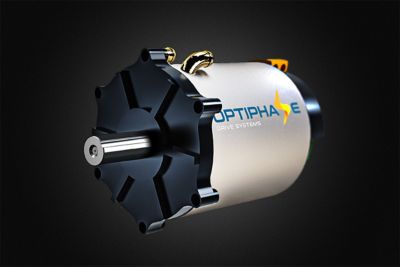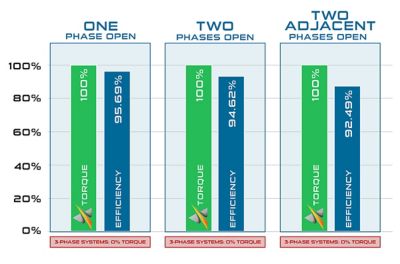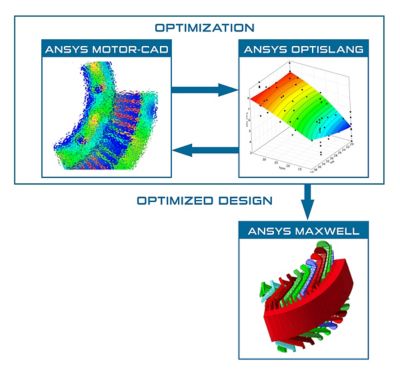-
-
학생용 무료 소프트웨어에 액세스하기
차세대 엔지니어에게 힘을 실어주는 Ansys
학생들은 세계적 수준의 시뮬레이션 소프트웨어를 무료로 이용할 수 있습니다.
-
지금 바로 Ansys에 연결하십시오!
미래를 설계하기
시뮬레이션이 다음 혁신을 어떻게 지원할 수 있는지 알아보려면 Ansys와 연결하십시오.
국가
무료 트라이얼
제품 및 서비스
학습하기
회사 정보
Back
제품 및 서비스
ANSYS BLOG
February 12, 2024
Ushering in the Next Phase of Electric Motor Design
From the automotive industry to aviation and industrial applications, electric motors are in the spotlight today. But there are still challenges to widespread adoption, including power levels and reliability. Optiphase Drive Systems is using Ansys software to launch an innovative five-phase motor design that could drive revolutionary change.
When it comes to electric vehicle (EV) motor engineering, a three-phase design is the industry standard for transforming electric power into mechanical energy. Invented by M. Dolivo-Dobrovolski in 1889 for AEG, Germany, three-phase motors rely on three alternating currents of the same frequency to generate the electromagnetic interactions capable of powering a vehicle.
Three-phase motors are well suited as traction motors for drive units of EVs. Their output power levels can be as high as 400 kW with rotational motor speed of up to 25,000 rpm, supporting vehicle axle speeds of up to 1,200 rpm.
While the performance of three-phase motors is impressive, they also have limitations. For instance, they lack the torque and power required for next-generation EV applications like aerospace and heavy machinery. They also have limited fault tolerance; if just one of the three phases fail, the motor loses torque and stops. And, finally, the most common solution for EV traction motors uses high-energy permanent magnets containing rare-earth metals, which is a sustainability concern.
Daniel Vicario and Siavash Sadeghi founded Optiphase Drive Systems (ODS) to address these limitations and expand the use of EVs beyond lightweight vehicles. The Texas-based startup is leveraging Ansys software to launch a five-phase EV motor design that could change the industry — and it’s attracting attention from both investors and government agencies. The Ansys Startup Program is supporting their efforts to make EV motors more powerful, more reliable, and more sustainable.

A sneak peek at the integrated system in development at ODS that combines the company’s five-phase motor and controller in one compact design.
Five-Phase Electric Motor: An Idea Whose Time Has Come
Vicario and Sadeghi worked together at Capstone Turbine (now Capstone Green Energy), a gas turbine manufacturer. When they both left the company in 2015, they decided to stay in touch based on their shared passion for motor design and entrepreneurship. Vicario moved on to positions at Parker Aerospace and Eaton, while Sadeghi worked for Honeywell, Supernal, and Hyperloop. For years, they kept in close contact.
“I knew Siavash was perfecting his design for a five-phase electric motor, and it represented a big idea — one that could truly upend the energy industry and deliver huge benefits to society,” says Vicario, the Chief Executive Officer of ODS. “We just had to wait for the right timing.”
The innovative motor design was developed by Sadeghi, now Chief Technology Officer at ODS, while earning his Ph.D. in electric machine design and control at Georgia Institute of Technology. “As a doctoral student, I did a lot of research and prototyping for the five-phase motor concept, and I continued refining it in my free time as my career took off,” he notes.
“Finally, I was able to reach a point where I believed the technology could be successfully commercialized,” continues Sadeghi. “Both Daniel and I realized it was time to pursue this full time.”
In early 2017, Vicario and Sadeghi founded ODS to focus on transforming that idea into a patented, commercialized product.
Driving Dramatic Progress in Vehicle Electrification
Five-phase motors operate in the same way as three-phase motors. However, as the torque is proportional to the number of phases, from the same motor volume and same current, an increase of more than 15% in torque is achieved. ODS five-phase motors deliver 17% more power, a 6% higher speed range, and 40% less current load per switch — all without increasing the size or weight of the motor — an enormous improvement over three-phase motors. Those specs could make EV motors suitable for a new range of high-power applications.
“The impressive power and torque delivered by this motor will open up a whole new range of industries and customers,” Sadeghi points out. “Heavyweight, heavy-duty vehicles such as those in the aerospace, defense, marine, construction, and agriculture industries can now be electrified, without the need to power them with multiple motors.” A proprietary control algorithm developed by Sadeghi, called ADAPTIV, helps minimize the current required by each switch, while maximizing power density. The result is a smaller, lighter-weight design that delivers extremely high power.
Five-phase motors from ODS also have a much greater fault tolerance than today’s three-phase designs. Up to two phases can fail, and the ODS motor will continue producing torque. This represents a significant improvement in reliability over three-phase designs.
Because Vicario is a former United States Navy officer and aviator, the reliability issue is especially close to his heart. “During my time flying long-range strike and reconnaissance missions of the back U.S. Navy warships, I experienced an equipment failure caused by a short circuit, which nearly cost me my life,” he explains. “That’s why I’m so passionate about reliable performance. Whether it’s a family car that’s driving through a remote location, a first-responder vehicle headed to an emergency, or an advanced aerospace application, we simply can’t allow EV motor failures. Our five-phase design dramatically reduces that risk.”
Environmental impact also plays a key part in electric motors. Thanks to their five-phase technology and proprietary designs, EV motors from ODS require less rare-earth metals. According to Vicario and Sadeghi, that’s an important advantage in an industry founded on the premise of environmental responsibility. It also contributes to a 25% estimated cost reduction when compared to the current generation of three-phase EV motors.

Powering Toward Commercialization with Ansys
While Vicario and Sadeghi don’t want to reveal too much, their five-phase motor design is already getting noticed by heavy equipment manufacturers, automakers, and U.S. government agencies. As just one example, ODS recently demonstrated its technology to the U.S. Air Force as part of its Unmanned Aircraft Systems (UAS) Power Generation Challenge. ODS earned this honor by submitting a proposal and advancing to the next round of competition, moving past some of the world’s aerospace leaders.
According to Sadeghi, engineering simulation has been critical in advancing the concept, verifying performance, and demonstrating its potential to both customers and investors. “In late 2022, we constructed a physical prototype motor in partnership with the University of Texas at Dallas. There were no surprises because simulation had already predicted the success of the design. A physical proof-of-concept is always going to be necessary, but simulation saves enormous amounts of time and money on the road to get there.
“Without simulation, we would need to spend millions of dollars building physical prototypes and iterating on them, and that’s just not possible for a startup,” adds Sadeghi. “Ansys software enables us to tweak components like magnets iteratively — not only to initially prove our concept, but also to adjust the basic design for different customer and industry applications Ansys is unique because the range of its toolkit allows us to simultaneously look at electromagnetic and mechanical performance aspects, as well as explore trade-offs.”

Both Vicario and Sadeghi are grateful for the chance to access Ansys software licensing through the Ansys Startup Program. “Ansys is literally investing in the future of small companies like ODS by giving us access to industry-leading development tools,” Vicario emphasizes. “When you’re starting a business, you don’t have a lot of cash flow. The Ansys Startup Program has really kept us in the game financially. We’re in a really exciting place, and we wouldn’t be here without Ansys.”
Learn more about the Ansys Startup Program.